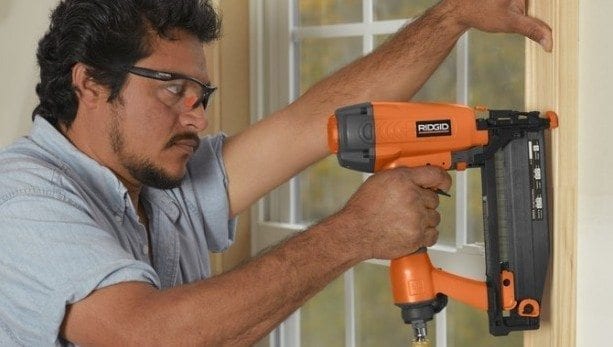
How to use a nail gun
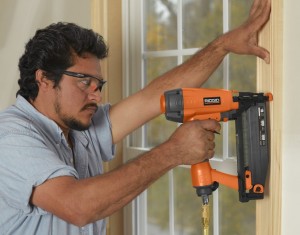
Never fire a nail gun while it’s pointed at any part of your body. If you must hold on to the work piece while nailing, keep your hand at least 12 inches away from the nail gun.
As recently as 20 years ago, nail guns were considered a luxury item by many contractors. Today, hundreds of thousands of them are used every day on construction jobsite across the country. They’ve greatly boosted productivity but they have also increased the number of construction injuries.
According to an Occupational Safety and Health Administration (OSHA) report, there are an estimated 37,000 emergency room visits every year due to nail gun accidents. The report also cites a study that found two out of five residential carpenter apprentices experienced a nail gun injury during a four-year period.
Most nail gun injuries occur during residential framing and sheathing work, but injuries during roofing, siding and finishing work are also very common. The best way to avoid these painful, and even fatal, injuries is to thoroughly understand the nail gun and learn how to use a nail gun safely under various conditions.
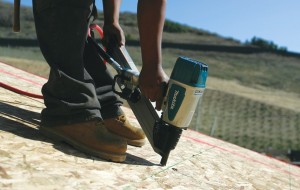
Bump-firing will increase production, especially when roofing or sheathing. However, this dangerous method should be reserved only for workers that know how to use a nail gun.
Know your nail gun
Nail guns have various trigger mechanisms, and to be safe you should know how each of them works. The two basic controls on all nail guns are the finger trigger and the contact safety tip (the nose of the nail gun). They work together to discharge the nail.
Variations include the order in which the trigger mechanisms are activated, and whether you can hold the trigger to discharge multiple nails (instead of releasing the trigger and squeezing it again for each individual nail). Combined, these variations result in at least four different types of trigger:
- Full sequential trigger. The safest type of trigger, it will only fire when the controls are activated in a certain order. First, the contact safety tip must be pushed into the work piece and then the trigger is squeezed to fire a nail. Both mechanisms must be released in order to fire another nail. Also known as single-shot, restrictive trigger, or trigger fire mode.
- Contact trigger. A contact trigger fires a nail when the mechanisms are activated in any order. You can push the contact safety tip first and then squeeze the trigger or vice versa. If you keep the trigger squeezed, you can drive a nail each time you push the contact safety tip into the work piece (known as “bump firing”). Also known as bump trigger, multi-shot trigger, successive trigger, dual-action, touch trip, contact tip, and bottom fire.
- Single sequential trigger. A single sequential trigger fires only when the controls are activated in a certain order (much like the full sequential trigger). First, the contact safety tip must be pushed in and then the trigger is squeezed to fire a nail. To fire a second nail, only the trigger must be released while the safety tip stays pressed into the work piece (finish nail guns with non-marring nose pieces commonly have this type of trigger). Nails cannot be bump fired with this type of trigger.
- Single actuation trigger. Like a contact trigger, this type will fire a single nail when the two mechanisms are activated in any order. Like the single sequential trigger, a second nail can be fired by releasing only the trigger and sliding the contact safety tip along the work piece, and then squeezing the trigger again. This trigger varies from the single sequential type in that the first nail can be bump fired (squeezing the trigger first then pushing the nose piece in), but successive nails must be driven by at least releasing the trigger and then squeezing again.
- Some nail guns have a selector switch that will allow you to choose among two or more systems, while others have only one standard mechanism. Tool manufacturers may have different names for their trigger actuation systems, so the bottom line is knowing how they work. Always read the tool manual.
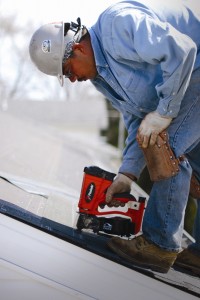
If you must nail while in an awkward position, push the safety tip into the work piece first and then squeeze the trigger.
How to use a nail gun
The most important nail gun safety feature (even more than the nose piece/trigger safety mechanism) is knowing how to use a nail gun properly. Common sense and good judgment will prevent most accidents. Avoid becoming too comfortable with your experience. As soon as you start to take the nail gun for granted, you’re primed for an accident.
Even if you know how to use a nail gun, review these tips and stay injury-free.
When you prepare to use a nail gun, never allow anything to touch or bump the trigger until you are ready to fire. (I once saw one experienced carpenter pass a nail gun through the rough opening of a window to another experienced carpenter on some staging outside. The nose piece contacted the second carpenter’s boot while the first carpenter had his finger near the trigger and the bump caused him to squeeze the trigger, nailing the second carpenter’s foot to the staging plank.)
Never fire a nail gun while it’s pointed at any part of your body. If you must hold on to the work piece while nailing, keep your hand at least 12 inches away from the nail gun. If you are using the nail gun for toe nailing or must nail while in an awkward position, push the contact safety tip into the work piece first and then squeeze the trigger. This makes careful nail placement easier and minimizes the risk of ricochet or blow-out.
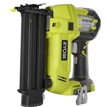
Nail guns have various trigger mechanisms. The two basic controls on all nail guns are the finger trigger and the contact safety tip.
Before you pull the trigger, be sure you know what’s on the other side of what you’re nailing. It’s not uncommon for someone that’s back-nailing sheathing, for example, to miss the stud on the other side. When that happens, the nail flies through the sheathing, becoming a sharp projectile. And if someone is nailing in your direction on the other side of a wall, stay clear.
Bump-firing (keeping the trigger squeezed while “bumping” the nose piece along to rapidly sink nails) will increase production, especially when roofing or sheathing. However, this dangerous method should be reserved only for workers with experience using this type of nail gun. Keep inexperienced workers limited to nail guns with full sequential triggers only.
Always wear personal protective equipment, including hard hats, safety glasses and hearing protection when using nail guns. Always disconnect the nail gun’s air supply when loading, unloading or clearing a jammed nail.
[tip id=”9405″]
